This fermented honey garlic is the perfect thing to make to boost your immune system! Both honey and garlic have strong medicinal benefits, so you’ll want to have this delicious home remedy on hand for cold and flu season.
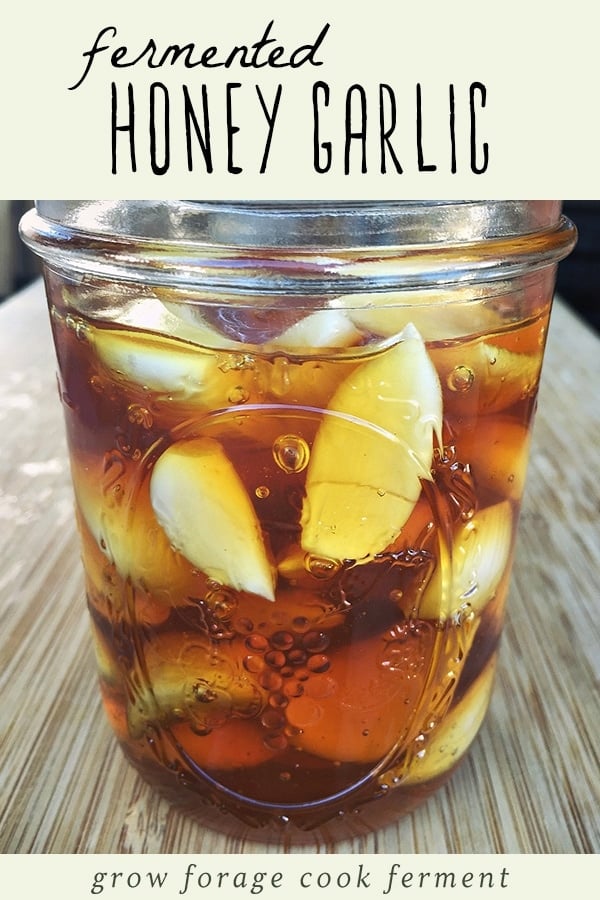
Want to save this post for later?
Fermenting Garlic in Honey
I’m really excited to share this post with you! Fermented honey garlic is something I’ve been wanting to try for a very long time, ever since I first read about it on the Killer Pickles blog.
I usually reserve my honey for mead making, but using it for other ferments intrigued me. Don’t ask me why I haven’t done it until now, because it’s the easiest thing in the world!
This tasty fermented garlic in honey can be used for many things, as good food and good medicine. Honestly though, I like to just eat it as is!
Fermented Honey Garlic Recipe
Making fermented honey garlic is so easy, it hardly needs a recipe!
Prepare the Garlic
The hardest and most time consuming part is prepping all of the garlic. Whatever size jar you use, you’ll want to fill it about 1/2-3/4 full of peeled garlic.
The quickest and easiest way to prep garlic is to place the side of a chef’s knife on top of a single clove and then give it a firm whack with the palm of your hand.
Don’t do it too hard, as you don’t want to crush the garlic, but just enough to lightly bruise the it. This will make it easy to peel, and will also release a bit of the garlic juice.
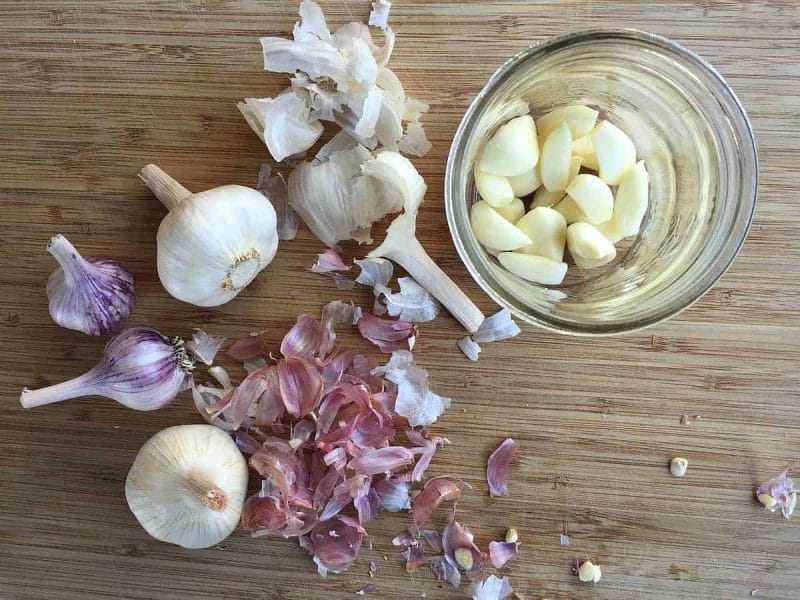
Add the Honey
Once you have enough garlic in your jar, pour in some raw honey to cover it. The garlic will probably float a bit and that’s ok.
It’s important to use raw honey to make fermented garlic in honey, as it will still have all the bacteria and wild yeast that is necessary for fermentation.
When liquid is added to honey, it jump starts the fermentation process. The small amount of juice from the garlic will create just enough liquid for fermentation to happen.
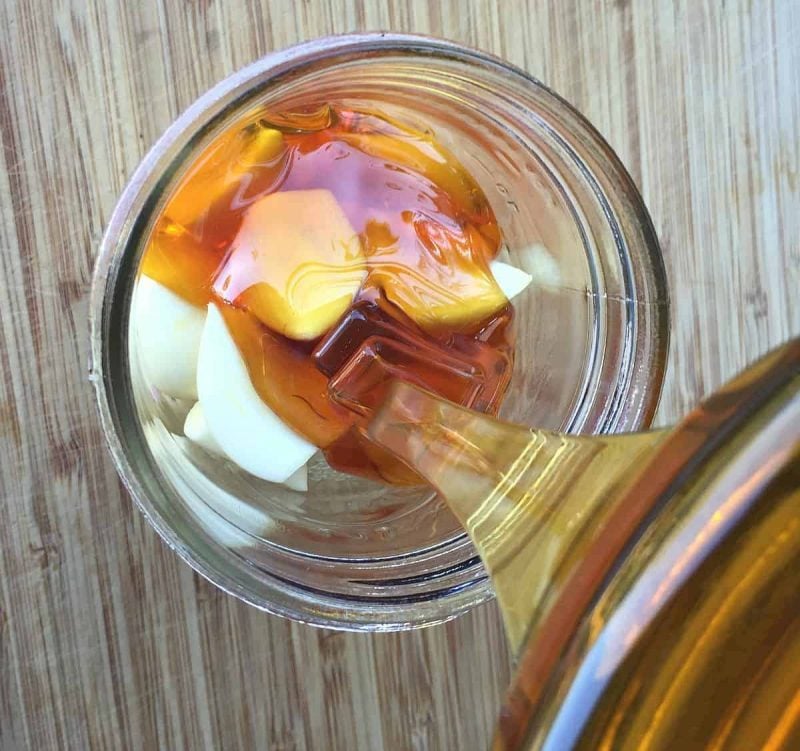
Cover and Flip
Cover the jar loosely with a lid to let the gasses escape, and put it in a dark place to ferment.
It’s a good idea to put a plate or something similar underneath the jar as it’s fermenting, as it will likely bubble up a bit and a little honey could possibly drip out.
It’s also important to gently turn the jar over every day or so, or whenever you think about it, to make sure that all of the garlic stay coated with honey.
Screw the lid on tightly before you do this! Then return it to it’s upright position and re-loosen the lid.
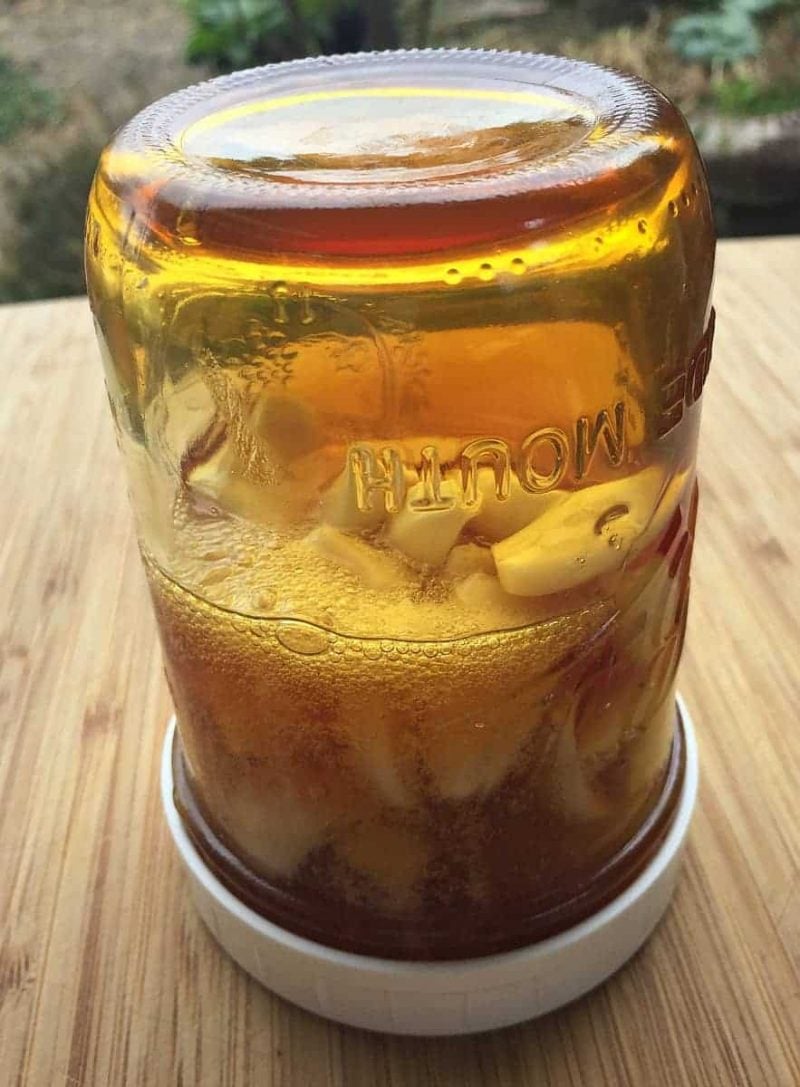
In a few days to a week you will notice some bubbles forming on the surface of the honey. Hooray!
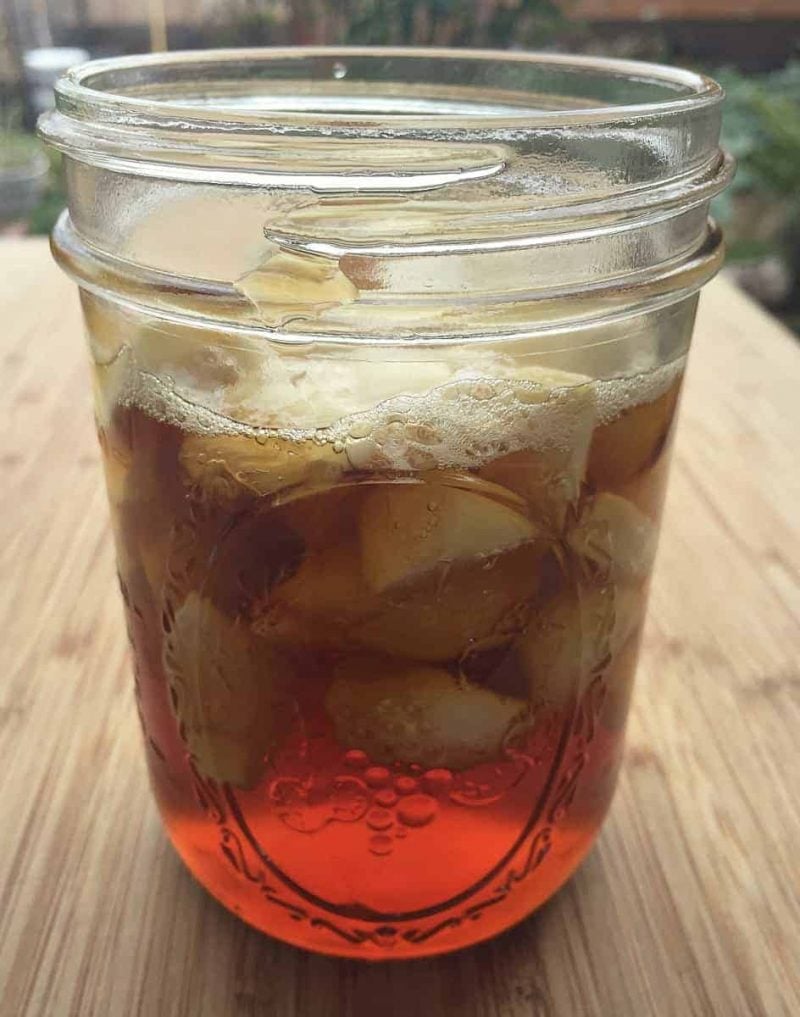
The honey garlic will ferment for about a month, but you can eat it at any time during the process.
The flavor will continue to develop over time, the garlic will mellow, and the honey will become much runnier.
Occasionally the garlic cloves turn a blue or green color due to a reaction during the fermentation process. While it may be a bit alarming, it is not harmful and the honey garlic can still be used.
Honey garlic will store well in a cool place for many months, or even a year or longer! I’ve kept some for over two years and it is still good.
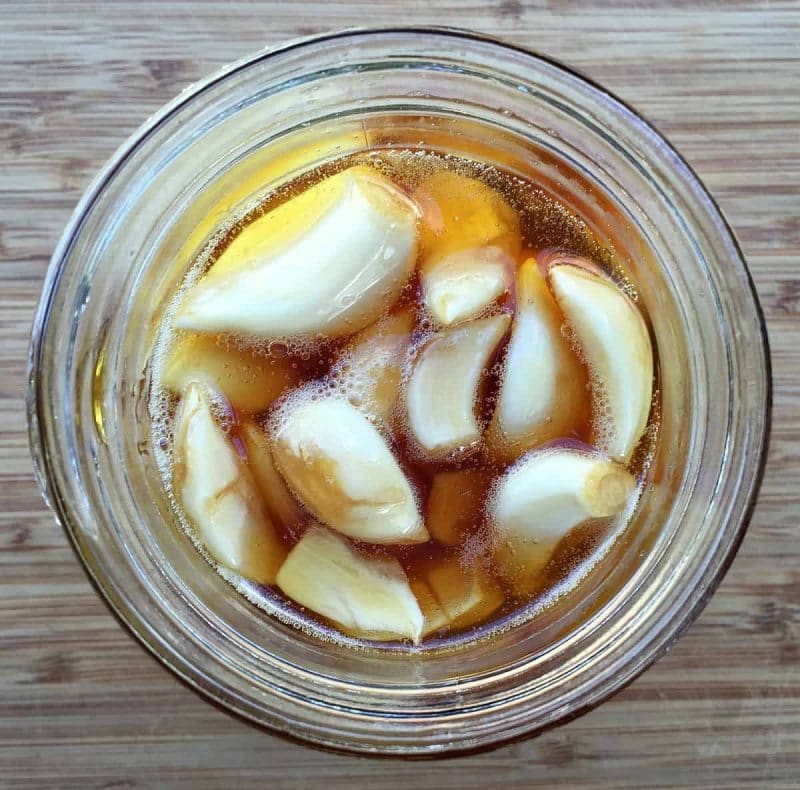
Using Fermented Honey Garlic
Now, how do you use this fermented honey garlic? That’s a good question, and it can be used in a variety of ways.
Both garlic and honey have strong medicinal properties, so it makes sense to use it as an immune booster or if you feel a cold or flu coming on.
Pop a whole garlic clove, or take a spoonful of honey (or both!).
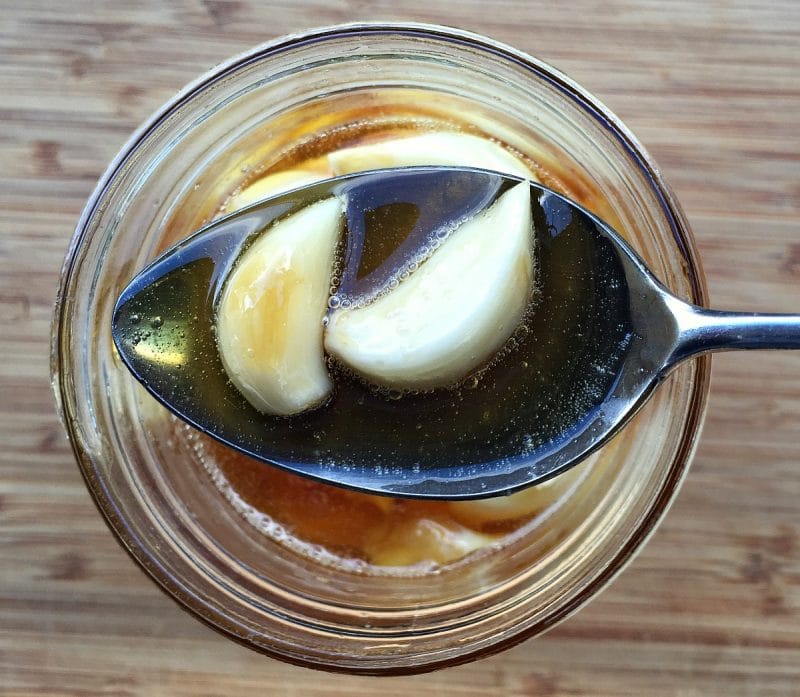
As you can probably imagine, honey garlic also makes a wonderful food!
It’s a natural in marinades and sauces, and would make a really tasty glaze for meats or veggies. Basically anything where you would normally use honey and garlic together!
Is Botulism a Concern in Honey Garlic?
I get this question a lot about fermented honey garlic! The short answer is no, botulism is really not a concern in this type of ferment.
While botulism can happen in garlic and oil preparations without added acidity, the fermentation process that happens here makes it very unlikely.
Raw honey is acidic, and while it can carry botulism spores (which is why it is not recommended for babies under 1 year), the level of acidity stops them from reproducing, which is what causes botulism.
If you are concerned about it, use a pH test strip. Botulism spores can’t reproduce with a pH of less than 4.6. Honey is usually around 3.9, but that can vary between brands.
If the pH is too high, add a splash of raw apple cider vinegar to add more acidity and retest. This is generally not needed, but I did want to mention it.
Honey garlic should not be given to babies under one year of age.
I really hope you make this yummy honeyed garlic! It’s super easy, and great to have on hand. I have a feeling it’s going to become a staple in our house!
Have you ever made fermented honey garlic? How do you use it?
More Fermented and Infused Honey Recipes
Enjoy these other recipes that showcase fermented and infused honey!
- Fermented Honey Cranberries
- Fermented Elderberry Honey
- Herbal Infused Honey
- Lilac Flower Infused Honey
Fermented Honey Garlic
Equipment
Ingredients
- 1 cup whole garlic cloves peeled and slightly crushed
- 1 cup raw honey or more, as needed to cover garlic
Instructions
- Place the peeled garlic cloves into a wide-mouth pint sized mason jar. Add enough honey to completely cover the garlic cloves. Make sure they are coated with honey.
- Place the lid on the jar loosely, then tuck into a dark place.
- Every day or so, tighten the lid on the jar and flip it upside down to coat the garlic cloves with honey. Loosen the lid again when you return it to the upright position.
- Within a few days to a week, you should see small bubbles start to form on the surface of the honey.
- The honey garlic will ferment for about a month, but you can eat it at any time. The flavor will continue to develop over time, the garlic will mellow, and the honey will become much runnier.
- Store in a cool place for many months or even a year, if not longer.
Notes
- It’s important to use raw honey for this recipe, as it has all of the bacteria and wild yeast that is necessary for fermentation.
- The small amount of juice from the garlic will create just enough liquid for fermentation to happen.
- It’s a good idea to put a plate underneath the jar during fermentation, as it will likely bubble up and a little bit of honey could possibly drip out.
- Occasionally the garlic cloves turn a bluish or greenish color during the fermentation process. While it may be a bit alarming, it is not harmful and the honey garlic can still be used.
- If you are concerned about botulism, use a pH test strip. Botulism spores can't reproduce with a pH of less than 4.6. Honey is usually around 3.9, but that can vary between brands.
- If the pH is too high, add a splash of raw apple cider vinegar to add more acidity and retest. This is generally not needed, but I do want to mention it.
- Honey garlic should not be given to babies under one year of age.

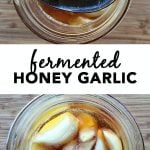
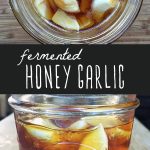
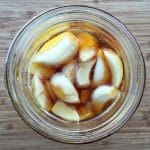

How much do you take a day?
A tablespoon or more. It’s really up to you!
How often do you take if you have a cold..
I take a tablespoon once a day.
Hi! Thank You for the recipe I haven’t made this yet but I am making it today. Can you use a lid that lets the c02 out on its own? Thanks!
Yes, you can!
Thank you! I have it made. I did a quart and filled it and left enough space I think. I did it as if I was canning tomatoes or salsa. I left about an inch or more at the top.
Wonderful. Enjoy!
I only had crystallized honey for my second batch, which I did warm up, but it wasn’t as runny as if it hadn’t crystallized. It’s thicker. Is that okay? The garlic is totally covered. When I turn it upside down, it kind of just blobs, not slowly runs like the other batch I made with non-crystallized honey.
Hi Tracy. It’s really hard for me to say. I think the honey would need to be non-crystalized for it to ferment the garlic fully.
Hi there. I’m wondering at what point in the process it is safe to fully tighten the lid on the jar and leave it. I’m making this for a friend for the winter holidays. :)
Hi Kat. It should take a month for the bubbling to stop.
Truly appreciate the way you made this wonderful fermented honey garlic. Everything is so nicely described that really helped me. Looking forward for more such recipes in future too.
Wonderful. Enjoy!
One question:
Since the honey ferments, is there an alcohol content after the fact?
Only a negligible amount.
Can I use Manuka honey to do this
Yes, you can!
Is it ok to use manuka honey if it is raw in the garlic.
Definitely!
I peeled and froze a lot of cloves from my own personal garlic harvest about two months ago (so they’re definitely free of any pesticides) Will they still ferment if I defrost them before using…or are they ruined for this particular recipe?
Hi Jocelyn, I think they should ferment just fine!
Oh my I have a question for you…while reading about the honey garlic you mentioned the possibility of botulism when using garlic and oil??? I myself have made some infused oils of sage, basil and garlic. Is this dangerous???? 😳
Yes, there’s always a small chance of botulism when infusing oils with plants that contain water content.
Do you eat the garlic?
Yes. It really mellows out as it ferments.
Are we to eat the garlic cloves?
I do, personally. Their flavor mellows out as it ferments making them pretty delicious, but you don’t have to eat them.
Hello, my honey from last year is crystallized, and we haven’t harvested this years honey yet. Can I use crystallized honey in this recipe? I don’t want to heat it and loose the raw benefits to make it runny again.
It would need to be runny to ferment the garlic, sorry! There are safe ways to decrystallize raw honey that won’t cause detriment to the raw honey health benefits.
Hi. I need help! I made this today but just read that the honey can’t be crystallized. I bought local honey and it was a bit crystallized. The garlic is in the jar already. I know you can decryatalize a jar by putting it in hot water. Should i do that. Or take the garlic out first and do it? Or is this ruined?
Hi Sarah. I would try placing the jar in warm water off and on until it’s no longer crystallized. It should still ferment but may take longer.
Mine leaked from being upside down :( Would you suggest I toss it and start again?
It’s probably fine, but it’s really hard for me to be sure since I don’t know the circumstances of why it leaked. Did you leave it upside down? I only turn it upside down for a few seconds to recoat any garlic that isn’t submerged under the honey.
Hi there, if i had consume all garlic. Can i still used the remain honey for another batch? Or what i should do with the remain honey.
Hi Lisa. It isn’t recommended to use the honey for another batch because as the sugar in the honey is consumed, it slows down and may not ferment the additional garlic safely. I use my fermented honey garlic for all sorts of things from drizzled over crusty bread to homemade salad dressings.
After consuming all garlic in honey, can i have 1 table spoon remian honey until it runs out.
Yes, for sure!
Does it need to be refrigerated after opened and you start consuming it?
Hi Leslie. No, the fermented honey doesn’t require refrigeration and will last for 12 months or longer in a cool, dark space in your pantry.
This recipe is delicious as you can imagine it would be. Although, I am wondering why in the world people keep asking about why to use organic? Hello! Because you should only EVER use organic produce, preferably homegrown! And the terms “regular” and “traditional” should be referring to organic. Vegetables and fruit do not naturally grow with chemical laced pesticides…….
But, I digress. This recipe is fabulous and you can take the spoonfuls of honey when you are sick or have a sore throat and will clear you right up! Thanks!
Thanks for sharing, Jasmine! I totally agree!
Hello I mostly had a question on the garlic being organic .. I made 2 version of it one with chili , ginger , and garlic and the traditional garlic one both did ferment great and I did test it with a pH strip before using the first time and it was fine .
I was just curious on why it needs to be organic . I know the pesticides stay on some things more than others (strawberries being notorious) I always thought the root veggies were negligible.
Typically organic garlic has its natural lactobacillus bacteria intact and isn’t stripped away by pesticides. Pesticides can also influence the taste, quality, and how quickly it ferments. If it’s working for you, then that’s wonderful, but I will continue to recommend only using organic.
I’m giving this a try, but I see you told Spazv the garlic MUST be organic or it won’t ferment. Why is that? I used regular garlic I bought at Sam’s and they seem to be fermenting nicely. Every other day when I turn the jar over and loosen the lid it burps.
Typically organic garlic has its natural lactobacillus bacteria intact and isn’t stripped away by pesticides. Pesticides can also influence the taste, quality, and how quickly it ferments. If it’s working for you, then that’s wonderful, but I will continue to recommend only using organic.
Thanks for the great recipe. I’m trying it today but I wonder do I need to keep it in a “cool” place as in inside a refrigerator? Because it’s hot summer now I’m not sure if I can just keep it in the kitchen cabinet.
A dark cabinet should be fine, as long it’s not over 90 degrees. Refrigeration is typically too cold and would slow the fermentation process considerably.
I bought regular garlic and put garlic and honey together. But it was not organic garlic. Have I just waited all the garlic and honey or is it still edible?
It may not ferment, but you’ll still have yourself some tasty infused garlic.
Hi- I have so many questions….
1) is organic garlic a must? if “yes” can you say why?
I made this 3 weeks ago coming this Sunday 5/30/21, the first week there were small noticeable bubbles. now almost 3 weeks in, there are no bubbles. The honey has gotten thinner over time and it smells really good. I turn and shake the bottle couple times a day. The garlic is also slowly turning brown……
2) (My second question), is everything still “good” after my description above?
3) will the cloves of garlic ever sink? lol when does this usually begin?
I tasted 2 cloves in week 2 and the garlic was raw, the honey was garlic infused. However I experienced those symptoms we get when we feel like vomiting (salivating a lot more than what’s normal for me etc.) I did not vomit though….the symptoms eventually passed.
4) Any idea if thats due to the garlic still being raw? or do you think my mixture is spoilt?
I thank you for you time and I look forward to hearing from you.
Thanks much!!
Spazv
1.) Yes, your garlic needs to be organic. It will not ferment otherwise.
2.) The timeline of your ferment sounds completely normal. The honey gets thinner over time and will turn brown with age.
3.) They should eventually sink over time.
4.) I can’t say whether or not they’re still raw or why you may have felt like vomiting. As long as you are flipping your jar periodically, it’s unlikely that it has spoiled. You can try adding a splash of vinegar to adjust the pH if you believe something is off with it.
Can i use a plastic lid on the jar?
Yes. Just be sure not to screw it on too tightly.
When i chop the garlic and pour the honey over it
I t turns green. Is it safe to consume
Yes, that is totally normal. When the sulfur in the garlic begins to break down in the honey, it will turn green or blue.
Can I use a clasp style canning jar or will it be too much pressure?
You could. I would just put a rubber band around the loosely covered lid’s clasp to avoid any pressure build up.
Hi – love garlic and honey! Can you chop the garlic finely before covering with honey? I’ve often read that garlic needs to be chopped to release the two chemicals that form the allicin which is where the healing come from, and let it sit for about ten minutes to allow that alchemy to form?
I usually crush them a bit to release the allicin. You can definitely chop them before covering them with the honey if you wish!
Thank you!
Hi please can it be used on skin
It could, but it’ll be really sticky.
Just use it in the shower as a cleanser and rinse it right off. I’ve used honey that way before and, being so sticky, I don’t think there is really any other way to use it topically. Unless you’re just dabbing a little on a scratch or something.
hi thanks for the info and recipe can i use peeled frozen garlic with this application
Fresh, organic garlic will give you the greatest chance of a successful fermentation.
Hi there, love this recipe and I’ve got a jar on the go now! One Question though – can I replenish the honey / garlic levels in the same jar by just adding more of either? or is it a one time thing where the amount at the start is it? Thanks!
I finish a jar and start another one.
If I forgot to mash my garlic before putting in the honey, does it still work the same?
Yes, it should. It may take it a little longer to get going though.